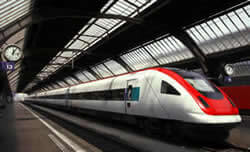- About
- Solutions
- Essentials
- Utilities
- Publications
- Product Delivery
- Support

A European railroad provides transportation and digital ticketing services for a large portion of the continent. The business unit manually sets prices based on historical purchases.
Fare pricing was unresponsive to consumer shifts in demand. The business unit was not able to react to the shifts quickly enough, which meant a loss in profitability due to setting prices too high (resulting in fewer sales) or too low (resulting in loss of revenue). The railroad needed to monitor its seat reservation activity in order to create a fare model reflecting the usage of the rail line.
Fare modeling was a computationally intensive application running on a Solaris system with an Oracle database.
In Figure 2, tickets are purchased based upon seat availability using an application on the NonStop Server. HPE Shadowbase heterogeneous bi-directional replication sends the reservation information to the Fare Model application on the Oracle Solaris server, which processes and analyzes supply and demand, calculating optimal pricing information. Then, the fare modeling application uses HPE Shadowbase software to return the updated pricing information to the NonStop Server, which updates ticket availability and pricing, and logs consumer demand so that the company can run further analysis to attain price equilibrium for optimum profits.
Contact us or your HPE Shadowbase representative, and learn how Shadowbase software will benefit you.
Related Case Study: ![]() Data Integration Solution for Paper Manufacturer
Data Integration Solution for Paper Manufacturer
Related White Paper: ![]() HPE Shadowbase Streams for Data Integration
HPE Shadowbase Streams for Data Integration
Related Solution Brief: HPE Shadowbase Data Replication Solutions